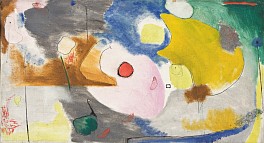BIOGRAPHY

American, 1921-1993
As a student of Hans Hofmann (one biographer says she was one of his star pupils), Rothschild’s early works reflect a young woman who was immersed in the vanguard of abstraction in America at a pivotal moment, just as it was becoming airborne.
Rothschild (1921-1993) was born to a wealthy Jewish family in New York. Following her graduation from Wellesley in 1943, Rothschild studied at the Art Students League with Reginald Marsh, at Stanley William Hayter’s Atelier 17, and with Hans Hofmann and Karl Knaths. Recognized as a gifted and precocious abstract painter, in 1945 she became a member of the Jane Street group, which included artists Leland Bell, Nell Blaine, Jane Freilicher, and Larry Rivers, and which promoted pure abstraction and rejected Social Realism Her first solo exhibition was held at their space, Jane Street Gallery, in December 1945. She would also go on to co-found the noted Long Point Gallery in Provincetown with others including Robert Motherwell and Paul Resika, among others.
This is an early work by the artist. One critic describes works from this period thusly:
"They are filled with floating ellipses, and geometries which float on warm, white grounds, sliced by the thinnest of black lines. The artist’s decisions seem to be effortlessly on course, a well-tempered performance affecting a sense of self-containment and openness."
Her work is included in the collections of many museums, such as the Metropolitan Museum of Art, the National Gallery of Art, the Phillips Collection, The Museum of Modern Art, the San Francisco Museum of Modern Art, Los Angeles County Museum of Art, the Solomon R. Guggenheim Museum, the Whitney Museum of American Art, the Philadelphia Museum of Art, the Baltimore Museum of Art, the Sammlung Ludwig Museum in Aachen, The Neuberger Museum, the Corcoran Gallery of Art, the Fogg Art Museum, and the Smith and Wellesley College art museums, and a number of museums abroad including The Tate Gallery, Centre Pompidou, and the State Russian Museum, St. Petersburg.
